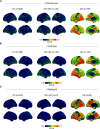A multicenter comparison of [18F]flortaucipir, [18F]RO948, and [18F]MK6240 tau PET tracers to detect a common target ROI for differential diagnosis
- PMID: 34041562
- PMCID: PMC8175317
- DOI: 10.1007/s00259-021-05401-4
A multicenter comparison of [18F]flortaucipir, [18F]RO948, and [18F]MK6240 tau PET tracers to detect a common target ROI for differential diagnosis
Abstract
Purpose: This study aims to determine whether comparable target regions of interest (ROIs) and cut-offs can be used across [18F]flortaucipir, [18F]RO948, and [18F]MK6240 tau positron emission tomography (PET) tracers for differential diagnosis of Alzheimer's disease (AD) dementia vs either cognitively unimpaired (CU) individuals or non-AD neurodegenerative diseases.
Methods: A total of 1755 participants underwent tau PET using either [18F]flortaucipir (n = 975), [18F]RO948 (n = 493), or [18F]MK6240 (n = 287). SUVR values were calculated across four theory-driven ROIs and several tracer-specific data-driven (hierarchical clustering) regions of interest (ROIs). Diagnostic performance and cut-offs for ROIs were determined using receiver operating characteristic analyses and the Youden index, respectively.
Results: Comparable diagnostic performance (area under the receiver operating characteristic curve [AUC]) was observed between theory- and data-driven ROIs. The theory-defined temporal meta-ROI generally performed very well for all three tracers (AUCs: 0.926-0.996). An SUVR value of approximately 1.35 was a common threshold when using this ROI.
Conclusion: The temporal meta-ROI can be used for differential diagnosis of dementia patients with [18F]flortaucipir, [18F]RO948, and [18F]MK6240 tau PET with high accuracy, and that using very similar cut-offs of around 1.35 SUVR. This ROI/SUVR cut-off can also be applied across tracers to define tau positivity.
Keywords: PET; Tau; [18F]Flortaucipir; [18F]MK6240; [18F]RO948.
Conflict of interest statement
Dr. Hansson reported receiving grants from Roche during the conduct of the study as well as grants from Roche, non-financial support from GE Healthcare, and grants from Biogen outside the submitted work. AL, TP, OS, PI, RS, NMC, ALB, HC, CHL, RLJ, GR, RO, and PRN report no conflicts of interest.
Figures



Similar articles
-
Diagnostic Performance of RO948 F 18 Tau Positron Emission Tomography in the Differentiation of Alzheimer Disease From Other Neurodegenerative Disorders.JAMA Neurol. 2020 Aug 1;77(8):955-965. doi: 10.1001/jamaneurol.2020.0989. JAMA Neurol. 2020. PMID: 32391858 Free PMC article.
-
Sex differences in off-target binding using tau positron emission tomography.Neuroimage Clin. 2021;31:102708. doi: 10.1016/j.nicl.2021.102708. Epub 2021 May 29. Neuroimage Clin. 2021. PMID: 34091353 Free PMC article.
-
Head-to-head comparison of tau positron emission tomography tracers [18F]flortaucipir and [18F]RO948.Eur J Nucl Med Mol Imaging. 2020 Feb;47(2):342-354. doi: 10.1007/s00259-019-04496-0. Epub 2019 Oct 14. Eur J Nucl Med Mol Imaging. 2020. PMID: 31612245 Free PMC article.
-
What's the cut-point?: a systematic investigation of tau PET thresholding methods.Alzheimers Res Ther. 2022 Apr 5;14(1):49. doi: 10.1186/s13195-022-00986-w. Alzheimers Res Ther. 2022. PMID: 35382866 Free PMC article. Review.
-
Targeted examination of amyloid beta and tau protein accumulation via positron emission tomography for the differential diagnosis of Alzheimer's disease based on the A/T(N) research framework.Clin Neurol Neurosurg. 2024 Jan;236:108071. doi: 10.1016/j.clineuro.2023.108071. Epub 2023 Nov 28. Clin Neurol Neurosurg. 2024. PMID: 38043158 Review.
Cited by
-
A review of the flortaucipir literature for positron emission tomography imaging of tau neurofibrillary tangles.Brain Commun. 2023 Nov 16;6(1):fcad305. doi: 10.1093/braincomms/fcad305. eCollection 2024. Brain Commun. 2023. PMID: 38187878 Free PMC article. Review.
-
Tauopathies: new perspectives and challenges.Mol Neurodegener. 2022 Apr 7;17(1):28. doi: 10.1186/s13024-022-00533-z. Mol Neurodegener. 2022. PMID: 35392986 Free PMC article. Review.
-
Sex-specific modulation of amyloid-β on tau phosphorylation underlies faster tangle accumulation in females.Brain. 2024 Apr 4;147(4):1497-1510. doi: 10.1093/brain/awad397. Brain. 2024. PMID: 37988283 Free PMC article.
-
Discriminative binding of tau PET tracers PI2620, MK6240 and RO948 in Alzheimer's disease, corticobasal degeneration and progressive supranuclear palsy brains.Mol Psychiatry. 2023 Mar;28(3):1272-1283. doi: 10.1038/s41380-022-01875-2. Epub 2022 Nov 29. Mol Psychiatry. 2023. PMID: 36447011 Free PMC article.
-
Collection on molecular imaging in neurodegeneration.Eur J Nucl Med Mol Imaging. 2023 Sep;50(11):3166-3167. doi: 10.1007/s00259-023-06347-5. Eur J Nucl Med Mol Imaging. 2023. PMID: 37480370 No abstract available.
References
Publication types
MeSH terms
Substances
LinkOut - more resources
Full Text Sources
Other Literature Sources
Medical

